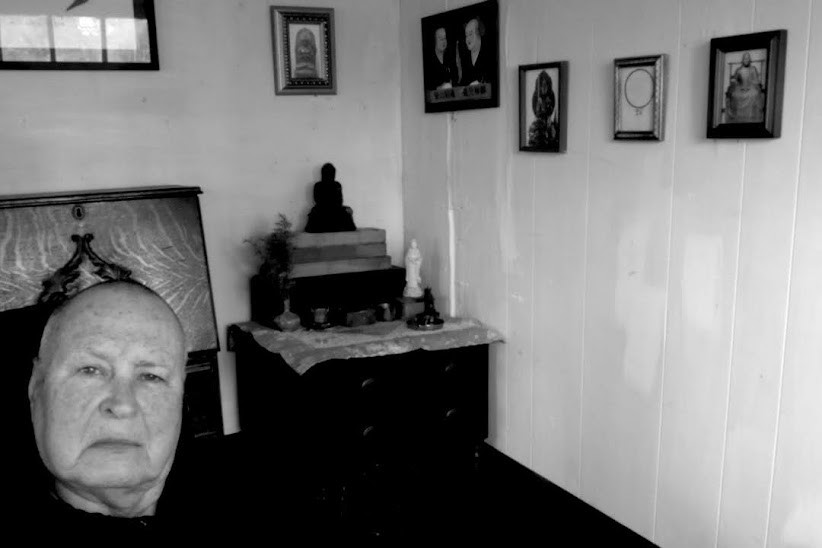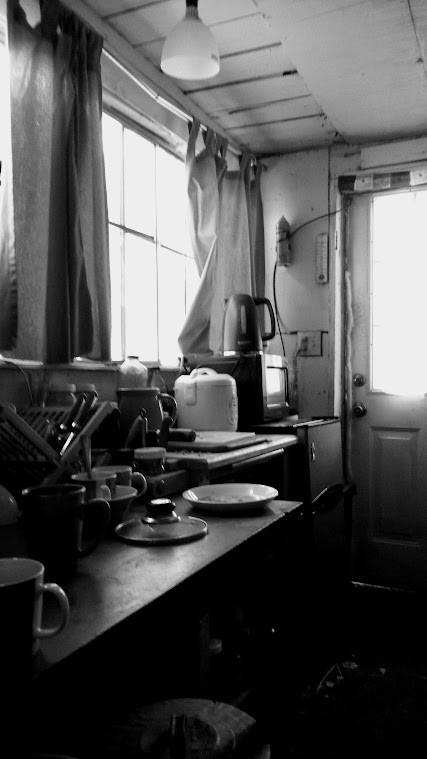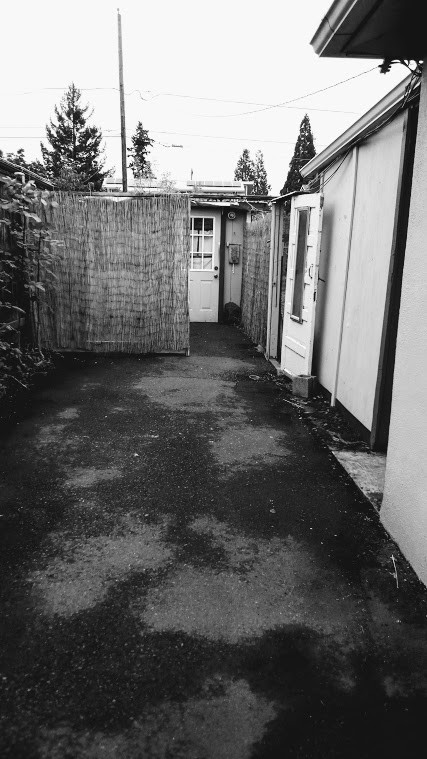The heat having abated somewhat (may reach 80F next 2 days -- in Eugene OR in Oct!! -- but to continue) I'm spending a lot more time in the hut. It's a tool shed dating back to the 50s, rebuilt for zazen practice and teleconferencing with the sangha (we mostly only meet online). I grow vegetables close at hand, pick "weeds" for tea, and use the tiny kitchen quite a lot. The leukemia seems to be in stasis for now. I greet crows outside my window.

Makeshift interior walls, makeshift altar, makeshift nun. At 75 and newly fragile health-wise, I sit here at the computer and commingle with my peers in the form of streams of electrons.
The altar table behind me was my grandmother's telephone table. The veneer secretary at left once belonged to the neighborhood landlord in my grandmother's time; don't know how she ended up with it! Picture frames, left to right: Prajnaparamita, Dogen and Keizan, Manjushri, an Enso, and Mugai Nyodai.
The kitchen is just a rice cooker, micro sized microwave, electric kettle, and a few jars and cans and utensils, most of them in a little hand-me-down butcher block table. I do most of my cooking in my eating bowl set inside the rice cooker liner in an inch or so of water. Works great. Table in the left foreground was my grandmother's from the 1930s. I ran my forehead into it on my scooter when I was three and just about knocked myself out.
I'm told I got up and tried again and again. Whirr, wham! Whirr, wham! There's a lesson in that somewhere.
 |
Stepping outside. The han is a plaque a friend made for me. I don't use it very often as there is no one to call with it and it's too near the neighbors. But I like having it. The mallet is a leatherworker's mallet that I retrieved from a dumpster somewhere.
 |
Manzoku-an (Hermitage of Enough) is a former tool shed at the end of what was once a long carport. It's nine by thirteen feet. I've built a little courtyard for it using framed reed mats. I have used this hut for part-time hermiting off and on for nine years, overlapping with the previous hut, Gogo-an (10X10'), which I used for about the same span, or for a combined total of eleven years.
 |
What have I learned from this activity? Not so very much; the skills for living simply -- even somewhat starkly -- were acquired in childhood, as my parents encouraged me in running wild in the woods. At thirteen I camped for a week on an island in a swamp in subzero weather, building a kind of beaver lodge for myself of sticks and leaves. I kept a fire going at the entrance, and chopped ice for water from the frozen creek with a hatchet.
As a young adult, I lived in a succession of yurts, vehicles and small travel trailers, moving from place to place for forestry contracting, and did not return to "civilization" until I was thirty-six. I then worked at a university for twenty-two years and retired, at fifty-nine, to farm an acre. Hand tools were the order of the day -- a return to simplicity.
When I began to study Zen with a teacher, I looked around the farm for a place to sit quietly out of the way, and the children's abandoned playhouse filled the bill. It did not take me long to move in a few items and begin cooking and even sometimes sleeping there as well as sitting zazen. This sort of thing just felt natural to me, and the family supported my efforts.
When I discovered an online sangha to sit with, I brought a laptop out to Gogo-an and practiced with them, even participating in an online ango and rohatsu. This was a change from hermiting -- or was it? Our routine was much like that of the Discalced Carmelite sisters, each in her own hut but gathering with the others for ritual.
Along came the pandemic and my local sangha moved online as well, where it has stayed ever since. These groups have a bit of a Carmelite flavor. Many of the people with whom I sit zazen or sesshin live alone. Many others practice with the assent of family members, but most do sit alone in their choice of room (or sometimes outdoors), as teleconferencing tends to place each person in a box, containing mostly a face, with perhaps an altar and bookcase in frame.
This mode of being isolated in company is not unfamiliar to monks and nuns in a monastery or local sangha. Benedictines gather, but each is alone with God in the company of others, perhaps to the extent of wearing a hooded cowl, or in the case of nuns, a coif, wimple and veil. Muslims have the sajada, or prayer rug, again alone with God amid the multitude. Zen practitioners tend to sit in a row, all facing the same direction, each alone with Dharma. Every religious person is already a hermit.
Religion, as we tend to define it, may not be the whole Venn diagram here.
People who live alone generally, or find themselves alone with or among others (there are many single beds in apartments, houses and ship cabins), or even who find themselves walking to the waterfront to commune with gulls and the stench of the wharf, are also hermits. Never make the mistake of supposing that someone who stops only briefly to admire a daffodil has no important business there.
Some may think they do not have hermiting skills, but I think we all do. What we may lack is the expectation that we'll have to live simply for an extended period of time, which can take some planning and prioritization. And in fact, though I have done that, it's not really what I'm doing right now; the hut is fifty feet from a shared modern kitchen.
But I like to practice living simply in the hut, to keep the skills up (y'know "just in case," or in case someone else needs to know the little that I know) and to support my Buddhist practice. I'm doing a lot of sits. I find they're good for me; I need centering. It's cheaper than psychotherapy.
As we find ourselves more and more constrained by our unwieldy modernity, with the likelihood of catastrophic weather events, pandemics and crop failures, we may make some effort, as is always commendable, to ease the burdens of those around us but cannot hope, as individuals, to remedy all.
What we can hope to do on our small scale (along with whatever else we're up to) is recognize that much of the time, what we might call down time or at least our in-between times, is what Buddhists call practice, which I will provisionally term as hermiting. Prayer, recollection, meditation, sittin' at the dock o' th' bay, admiring a daffodil, these are things that most anyone can do as they come to them, but I think we also, many of us, recognize that there are skilled ways of going about solitude. We know skilled loners when we see them, whether in films, videos, or sidewalk encounters.
Your bedroom, your kitchen, your study (if you have one), your creekside path, your hut attached to the family home or in its back yard (see under hermitary) -- your brief alone time "amid the noise and the haste" is your practice place. Whatever practice you do there, may it flow as a spring of water of life for you, and may you, in your short time here, find whatever you may recognize as blessing.
No comments:
Post a Comment
Stony Run Farm: Life on One Acre